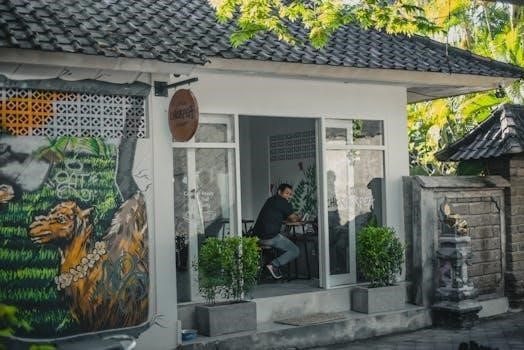Understanding Your Slow Cooker
Slow cookers, also known as crock-pots, are countertop electrical appliances designed for unattended cooking at low temperatures. These devices offer a convenient way to prepare meals, from soups and stews to tender meats. They come in various forms, including ceramic crocks, metal pots, and even pressure cookers with a slow cook mode.
What is a Slow Cooker/Crock-Pot?
A slow cooker, often referred to as a crock-pot, is a versatile kitchen appliance designed for cooking food over an extended period at low temperatures. This countertop electrical device is engineered to cook food unattended for hours, making it an ideal solution for busy individuals or families. Slow cookers typically consist of a base unit that houses the heating element and a removable cooking pot, often made of ceramic, metal, or other heat-resistant materials. The low heat and long cooking times allow flavors to meld together, resulting in delicious and tender meals. They’re incredibly user-friendly, requiring minimal preparation and supervision, allowing for ease in creating a variety of dishes such as soups, stews, casseroles, and braised meats. The slow and even heat distribution prevents burning, making it a forgiving method of cooking suitable for many types of cuisine. Simplicity is key, as many recipes require minimal pre-preparation steps, often just tossing all the ingredients in.
Different Types of Slow Cookers
While the classic slow cooker often brings to mind a heavy ceramic pot, the market now offers a variety of types to suit different needs and preferences. Traditional models feature a ceramic crock, which is ideal for slow and even heat distribution, perfect for classic recipes like stews and roasts. However, many modern slow cookers come with metal pots that are not only lighter but can also be used for searing meats before slow cooking, adding another dimension to your cooking. Additionally, some pressure cookers now incorporate a slow cook mode, offering the convenience of both functions in one appliance. Electric Dutch ovens have also entered the arena, combining the benefits of a traditional Dutch oven with the convenience of slow cooking. These various types cater to diverse cooking styles, allowing users to choose the one best suited for their recipes and kitchen requirements. Regardless of the type, all slow cookers provide a wonderful way to create budget-friendly and convenient home-cooked meals.
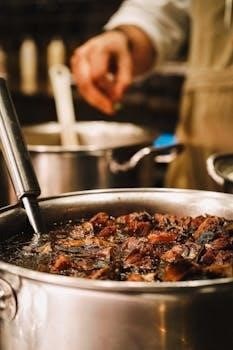
Essential Slow Cooker Techniques
Mastering slow cooking involves key techniques like proper ingredient preparation, layering, and liquid management. These steps ensure even cooking and prevent common issues like dryness or uneven flavor distribution. Proper techniques are crucial for success.
Preparing Ingredients for Slow Cooking
Simplicity is key with slow cooking, so choose recipes requiring minimal pre-prep. For many dishes like soups and stews, simply tossing ingredients in works well. While pre-cooking onions can add a distinct flavor, it’s not always necessary; experiment to find your preference. Browning meat, although beneficial for color, is also often optional. For busy mornings, prepare ingredients the night before, storing them in the cooker’s dish in the fridge. Allow the dish to sit at room temperature for about twenty minutes before starting the cooker for optimal results. Inexpensive cuts of meat like brisket, pork shoulder, and chicken thighs work particularly well. Trim excess fat from meat, as it won’t drain away like in frying. You can even enhance the meal with more vegetables. Remember, preparation is key to a successful slow-cooked meal.
Layering Ingredients Properly
Proper layering in your slow cooker ensures even cooking and prevents certain ingredients from overcooking or undercooking. Start by placing denser, slower-cooking items, such as root vegetables, at the bottom and around the sides of the pot; this position provides maximum exposure to the heat source. Arrange meat and other vegetables evenly over the root vegetables. Add liquids last, ensuring they cover the ingredients adequately without overfilling the cooker. Be mindful not to exceed three-quarters full to prevent leaks and to allow for proper cooking. This systematic approach distributes heat more effectively, leading to a more balanced and flavorful dish. Remember, the order of ingredients significantly impacts the final outcome of your slow-cooked meals.
Liquid Management in Slow Cooking
Managing liquids effectively in a slow cooker is crucial for successful cooking. Due to the airtight seal of the slow cooker, liquids do not evaporate as they would in traditional cooking methods. Therefore, when adapting a recipe, reduce the liquid by about one-third. Aim for a level that adequately covers the meat and vegetables but does not overfill the pot. Overfilling can lead to leaks and hinder proper cooking. It is generally recommended to fill the slow cooker to about half to two-thirds capacity, never exceeding three-quarters full. Be mindful of the moisture already present in vegetables; this will release during cooking, adding to the overall liquid content. Accurate liquid management ensures your dishes are perfectly cooked, not too soupy or dry.
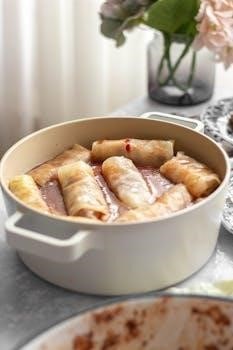
Optimizing Slow Cooker Performance
To get the best results from your slow cooker, understanding heat settings and how to manage liquids is key. Knowing when to thicken sauces and avoiding common mistakes will elevate your slow-cooked meals.
Low vs High Heat Settings
When using a slow cooker, the choice between low and high heat settings can significantly impact your meal. The low setting is often favored for its gentle, gradual heating process, which allows flavors to meld beautifully over an extended period. This is particularly beneficial for tougher cuts of meat that require longer cooking times to become tender. Many chefs recommend using the low setting whenever possible, envisioning it as a “culinary fairy” working while you’re away, slowly and thoroughly cooking your meal. This option also provides the convenience of leaving the cooker unattended for hours, making it ideal for busy days.
The high setting, on the other hand, is designed for quicker cooking. While it can be useful when you are short on time, it’s important to note that the high setting can sometimes lead to overcooking or uneven cooking, if not monitored carefully. The low setting generally yields better results by developing richer flavors and achieving optimal tenderness.
When to Thicken Sauces
One unique aspect of slow cooking is that liquids do not naturally reduce or thicken as they do in traditional stovetop cooking; This is due to the airtight seal of the slow cooker, which prevents evaporation. Therefore, if you’re aiming for a thicker sauce or gravy in your slow-cooked dish, you’ll need to take specific steps to achieve it. There are a couple of effective methods to thicken sauces in a slow cooker. One approach is to coat your meat with a light layer of seasoned flour before adding it to the pot; this can act as a thickening agent as the dish cooks. Another popular method involves using cornflour at the end of the cooking process. To do this, create a paste by mixing a teaspoon or two of cornflour with cold water. Once smooth, stir this mixture into your simmering slow cooker ingredients, and reseal the lid for a short period, allowing the sauce to thicken to your desired consistency. Remember to adjust the amount of thickening agent based on the quantity of liquid you want to thicken, and its very important to use cold water to make a paste, not hot.
Avoiding Common Slow Cooker Mistakes
Several common mistakes can hinder your slow-cooking success, but they are easily avoidable with a bit of knowledge. One frequent error is opening the lid too often during the cooking process. Each time you lift the lid, heat escapes, potentially prolonging the cooking time and affecting the overall result. Slow cookers are designed to operate independently, minimizing the need for frequent checks. Another mistake is failing to layer ingredients properly; denser items like root vegetables should be placed at the bottom, closer to the heat source. Also, be sure to not overfill your slow cooker. The ideal level is half to two-thirds full to prevent leaks and ensure even cooking. Additionally, resist the urge to add too much liquid, as it doesn’t evaporate much in a slow cooker. Finally, remember that while you can add frozen foods, thawing them is recommended for even cooking and food safety, especially with meats, as proper thawing is key for food safety. By keeping these points in mind you will avoid most common mistakes.
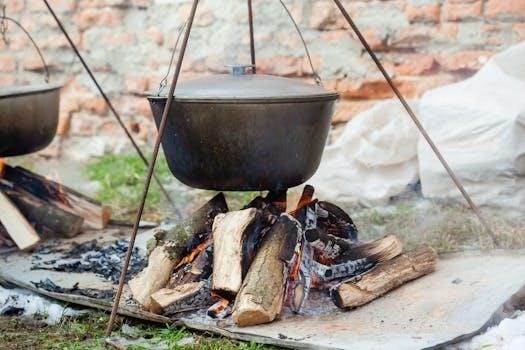
Practical Tips and Safety
Selecting the correct slow cooker size is important. Clean your slow cooker before its first use. Always place it on a stable surface and never overfill it. Follow safety guidelines and use recipes designed for slow cookers.
Choosing the Right Size Slow Cooker
Selecting the appropriate size of slow cooker is crucial for successful meal preparation. The size you need largely depends on the number of people you typically cook for. A 4- to 6-quart slow cooker is generally well-suited for small to medium-sized families, providing enough capacity for most standard recipes. These sizes are versatile and can handle a range of dishes, from everyday meals to small gatherings. If you frequently cook for larger groups or like to prepare meals in advance for freezing, consider opting for a larger model. Larger slow cookers are ideal for bigger gatherings, potlucks, or when you have many mouths to feed. For those living alone or couples, smaller models, like a 2- to 3-quart slow cooker, might be the most practical option. These are great for single servings, dips, or smaller side dishes. Remember that the capacity can also affect cooking times, with larger cookers potentially needing a bit more time to reach the desired temperature. Carefully assess your typical cooking needs to ensure you choose the right size for your household.
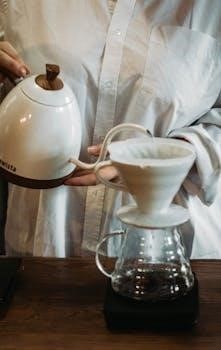
Initial Setup and Cleaning
Before using your slow cooker for the first time, it’s essential to prepare it properly. Start by washing the removable stoneware insert and the lid with warm, soapy water. This step ensures any manufacturing residues are removed. Rinse them thoroughly and allow them to air dry or wipe them with a clean cloth. Next, take a damp cloth and wipe down the base of the slow cooker, being careful not to submerge it in water. This will clean the exterior and any dust that may have accumulated. Regularly cleaning your slow cooker after each use is crucial for maintaining its performance and hygiene. Always clean the removable stoneware and lid immediately after use. For stubborn stains, a paste of baking soda and water can be effective; Let the paste sit for a while before scrubbing and rinsing. Avoid using abrasive cleaners or scouring pads, as they can damage the ceramic. Keeping your slow cooker clean is the key to making it last longer.
Safety Precautions and Usage Guidelines
When using a slow cooker, safety should always be a priority. Begin by placing the appliance on a stable, heat-resistant surface, away from flammable materials. Ensure proper ventilation around the cooker to prevent overheating. Never overfill the slow cooker, as this can cause leaks and hinder proper cooking; typically, filling it halfway to two-thirds is recommended. Always use oven mitts when handling the hot stoneware or lid, and avoid touching the slow cooker’s exterior while it is operating. It’s generally safe to use frozen ingredients, but thawing is preferable for even cooking, particularly for meat. Always follow recommended cooking times, and avoid leaving perishable foods in the slow cooker on the “warm” setting for extended periods. Never submerge the base of the slow cooker in water or any other liquid. It is crucial to read and follow the manufacturer’s instructions for specific safety guidelines.

